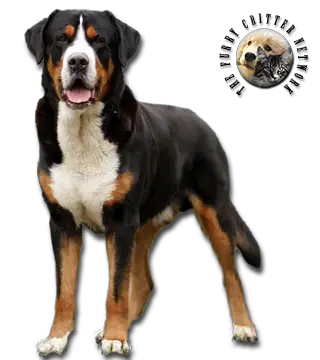Breed Standard
Head: Powerful without bulkiness. Broad, flat skull. Stop not pronounced. Powerful muzzle. Black lips.
Ears: Medium size, set on moderately high, triangular, hanging flat against the cheeks.
Eyes: Medium size, almond shape. Hazelnut or chestnut color.
Body: Powerful but not massive. Powerful, thick neck without dewlap. Broad, well let down chest. Broad forechest. Belly and flanks slightly tucked up.
Tail: Thick, hanging down and reaching the hocks at rest.
Hair: Medium length, dense. Thick undercoat.
Coat: Black background with symmetrical rich rust and white markings. Rust markings between the black and white markings on the cheeks, above the eyes, inside the ears, on each side of the chest, on all four legs, and under the tail. White blaze and muzzle; white markings on forechest, feet, and tip of the tail.
Size: Dog: 65 to 72 cm Bitch: 60 to 68 cm.
Weight: Dog: approx. 40 kg Bitch: approx. 35 kg
History
The ancestors of the Greater Swiss Mountain Dog are the powerful tri-color dogs referred to as (butcher mastiffs.) In the latter Middle Ages, this breed went to battle with Swiss soldiers. In 1908, two Short-haired Bernese Mountain Dogs were exhibited at a show. Dr. Albert Heim was present at the show and recognized them as survivors of the large butcher mastiffs that were on the verge of extinction. In 1909, the Swiss registry recognized the variety as a distinct breed. The Greater Swiss Mountain Dog club, created in 1912, implemented a breeding program to restore the breed. The standard for the Greater Swiss Mountain Dog was published for the first time by the FCI in 1939.
Behavior
The Greater Swiss Mountain Dog is happy with an enthusiastic nature and strong affinity to people and children. This breed is sociable, active, calm and dignified. While the breed does need exercise, they do not need a vast space. The breed often stands close to their owners, rarely straying far away without checking in. They will not be happy confined to kennel life; they want to enjoy their family. They crave attention and physical contact. Greater Swiss Mountain Dogs are bold, faithful and willing workers and are eager to please. The Greater Swiss Mountain Dog is confident in nature; the breed is gentle with children. They can be stubborn and determined. The Greater Swiss Mountain Dog is an intelligent breed and is a quick learner. They can be difficult to housebreak, taking up to 6 months or more.
The activity level in the Greater Swiss Mountain Dog is variable. They are capable of being athletic, but usually that activity is in bursts; they are active for short periods of time followed by napping. They want to be with their owners and to participate; their activity level most often matches the activity level of the family. As a working dog, they like having a job to do and enjoy participating in hiking, carting, obedience trials, herding, weight pulling and backpacking with their owners.
Being alert and vigilant, the Greater Swiss Mountain Dog is a good watchdog. They tend to notice everything in their surroundings and are quick to sound alarm. Faced with a threat, they will stand their ground and put on a show that will intimidate those unfamiliar with the dog. Greater Swiss Mountain Dogs are accepting of a non-threatening stranger. They are confident and comfortable in unfamiliar locations, and are stable around strange noises and unfamiliar people. They are accepting of other dogs and species, and are reluctant to bite.
This giant breed matures slowly in both mind and body, taking anywhere from 2 to 3 years. The objective in training this dog is for the owner to build trust through humane methods. As youngsters, they can be quite boisterous and they do require steady and reliable training to develop manners and physical self-control. As with all large, active working dogs, this breed should be well socialized early in life with other dogs and people, and be provided with regular activity and training.
The Greater Swiss Mountain Dog needs a lot of exercise and room to run. Regular brushing is required.
Function
Cattle Driver, Draft Dog, Guard Dog, Rescue Dog, Pet.
Health
For the most part, this breed is relatively healthy for their size; Greater Swiss Mountain Dogs have far fewer problems than more populous breeds in the similar size range.
Urinary incontinence
Entropion
Lick fit - is the frantic licking in which Greater Swiss Mountain Dogs can be prone. This has been reported in 17% of the breed. When in the middle of a lick fit, the dog will lick anything they can - carpet, floors, walls and will eat anything they can find, including grass, leaves, dirt, carpet, and will gulp air and swallow constantly. Their actions make it obvious they are in severe gastrointestinal discomfort. Many owners are able to prevent lick fits by ensuring the dog never has an empty stomach by frequent, smaller meals and large dog biscuits as between meal snacks.
Epilepsy
Abdominal health issues
Dysplasias






